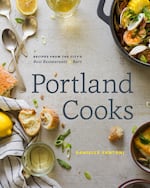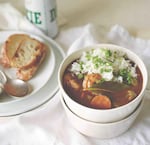How do Portland's most adventurous diners decode the Creole/Cajun-meets-Viet/Asian menu at Tapalaya restaurant?

"Portland Cooks" by Danielle Centoni features 80 recipes from 40 of the city's tastiest eateries.
Leela Cyd
“Hanoi and New Orleans are at the same latitude and near oceans, so they grow the same vegetation and produce lots of seafood-hearty dishes,” chef/owner Anh Luu said of her highly personal culinary style. “The flavors are very spicy" and complement one another. And both cuisines are steeped in French influence.
Luu's Chicken, Shrimp and Andouille Sausage Gumbo is one of 80 recipes from 40 signature eateries in "Portland Cooks, Recipes from the City's Best Restaurants & Bars" by Danielle Centoni. Portland is the first U.S. city to be featured in the Vancouver, BC-based Figure 1 Publishing series.
3 quintessential Portland restaurants
By Danielle Centoni
Elephants Delicatessen (eight locations): Beloved cornerstone institution since 1979; developed 4,000 recipes; offered the first taste of many gourmet foods; busy catering operation; still evolving and current. Recipe: Grilled Wild Salmon with Hazelnut Butter and Cabbage, Fennel and Frisée Sauté.
Mae (Northeast): Supertalented Maya Lovelace's Northeast pop-up has staying power. The place is a phenomenon. You get on the email announcement list and click on links for tickets. Delicious, crowd-pleasing Southern food that people want to cook at home. Recipe: Brown Sugar and Cocoa Nib Pound Cake with Brown Butter Icing.
Clyde Common restaurant (West Burnside): The Portland drinks scene is as important as its food scene, and other cities look to us for trends. Its very talented bartenders started the craft cocktail and they have cocktails on tap. Recipe: Bourbon Renewal.
Through a dozen years, food writer and editor Centoni has watched as outsiders have ventured into Portland, gasped at the provocative scene locals take for granted and then scurried away — tastebuds tingling — to bleat to a wider world the news of the city's latest "innovation." For "Portland Cooks," she said she sought out the “pioneers, game-changers, upstarts and torch-bearers,” demanding their most accessible home-kitchen recipes to celebrate the city’s remarkable arc.
More: Recipe For Chicken, Shrimp And Andouille Sausage Gumbo
Pass through the door of any restaurant featured in the cookbook — from Acadia Bistro to Xico — and catch whiffs of its history.
From Vietnam To NOLA
This is how Luu tells her story: One morning in 1966, her 23-year-old father, Tac Luu, was on his way to work at the university in Hanoi when the Americans started bombing. He hid under a tree but was struck by shrapnel and then rushed to a hospital, where his father was a doctor. Anh Luu's mother, Tam Tran, was a 16-year-old volunteer nurse working there that day. Tac Luu almost died from his wounds, which left scars resembling a big face on his right upper arm. Four years later, Tac Luu and Tran were married; they had a daughter and a son. Tac Luu worked as a university music instructor.
The last U.S. combat troops left South Vietnam in 1973, but yearslong conflicts developed between Vietnam and China. Tac Luu was an ethnic Chinese and believed he could be targeted, so in 1979 the couple decided to leave Vietnam with their children in search of a better life.
Tac Luu’s brother-in-law stole the large commercial fishing boat he worked on and 11 family members fled over the South China Sea to Hong Kong, where the vessel was confiscated, and they were put into a refugee camp. On his sponsorship application, Luu listed the United Kingdom as his top-choice destination. But a Michigan Methodist church made an offer, so after six months the family emigrated, spending a few days in a Los Angeles refugee camp before settling in Ann Arbor. The church provided them with an apartment, furnishings and clothes and found Luu a job.

Portland restaurateur Anh Luu embraces elements of Vietnamese cooking learned from her refugee mother and the Creole/Cajun cuisines of New Orleans, where she grew up.
Leela Cyd
The boat-thief brother-in-law commuted to the Gulf for monthlong deep-sea fishing jobs and finally moved to New Orleans. By describing how much like home — Vietnam — the region was, he persuaded the rest of the family to follow. Anh was born there in 1986.
Anh Luu’s dad did odd jobs and studied electronics repair, finding work in a TV repair shop. The family of five lived in an apartment upstairs. Luu bought the business and later a four-bedroom house with a pool “not a mile from Lake Pontchartrain. I was the lucky one,” Anh Luu said. “Before I was born, the family was super poor. In east New Orleans, we were upper-middle class.
“I knew my family was very different, but my parents didn’t talk about the hard parts. They shielded the kids. I never felt any of the stress of being a refugee. My parents gave me a really good life.” Sent on scholarship to a private K-8 school, she “hung out with the kids of very wealthy families who lived in old mansions in the Garden District. I was the only nonwhite student.” Many Vietnamese refugees were Catholic but her family was Buddhist. “The Catholic community had large gatherings. We were family oriented.”
“My mother made dinner from scratch every day,” Luu said. “She could relate to New Orleans. She didn’t speak English but was always feeding everyone, throwing parties by the pool. I cook the way I do based on flavor memories from childhood.”
Luu’s mother assigned her tasks and oversaw her work peeling shallots, shelling peanuts, picking herbs for a platter. “She made a brothy soup with vegetables, cabbage, lime juice and fish sauce, maybe a pork bone. It was self-serve: Scoop the rice into your bowl and then the broth," Luu said. Dinner included meat and vegetable dishes and condiments like ubiquitous pickled mustard greens.
At age 15, while attending public high school, Luu got a job at a grill owned by a friend’s parents, the first in a series of front-of-house restaurant jobs in New Orleans. “I had just started driving. My mother also gave me a thick skin.”
In Katrina's Wake
Then in 2005, heavy flooding from the surge following Hurricane Katrina destroyed her family’s carefully built life.
“My parents lost everything: their home, the cars, my dad’s business,” she said. Soon the couple crossed the country to Clackamas, Oregon, observing Vietnamese tradition by living with their oldest child and her family. About a year later, they all moved to a 5-acre plot on the Tualatin River in West Linn, where the parents had their own apartment within the house.
Anh Luu, 19, stayed behind, transferring from college to college and working New Orleans restaurant jobs. “After Katrina, I started to think about race identity and roots,” she said. “The moment I knew I wanted to be a chef, I felt that.”
In 2009, Luu moved to Portland to attend the Western Culinary Institute and rejoin her family. During her first turn at Tapalaya, located on Northeast 28th Avenue at Burnside Street, she expanded the Cajun/Creole tapas menu to include Asian-influenced items. Since returning as executive chef in 2013, she’s aspired to “make people enjoy what they normally don’t like to eat.” This might explain her pop-up nights featuring the "phorrito," which she describes as “everything in a bowl of pho wrapped in a tortilla.”
Garden Brings Memories, Bounty
In March, Luu purchased Tapalaya, but the event was marked by tragedy. Days before the sale's completion, her mother died in a car crash. She was 67.
“Mom was one of 13 children. Having an international family, none of the Vietnamese relatives could come for the funeral,” Luu said. “It was very Buddhist.” Her Vietnamese family set up a prayer area — an altar — in the town where she was born.
Tac Luu, 74, remains at the family home in West Linn, where his wife had tended a 1/12th-acre garden for a decade. “This summer," Anh Luu said, "I was surprised to see random starts of short-lived Vietnamese herbs, like Vietnamese celery,” skinny, long and leafy. Shiso and garlic appeared. The soil was rich and Luu planted other things: tomatoes, squash, eggplants, greens. All summer she carried this bounty to the restaurant and folded it into her cooking.
“I used to see my mother working in the garden, so I can feel her there now.”

Asian and Cajun/Creole ingredients — lemongrass, Creole seasoning, fish sauce — brighten and enliven Chicken, Shrimp and Andouille Sausage Gumbo, served with rice. The recipe is featured in the cookbook "Portland Cooks."
Leela Cyd
Chicken, Shrimp, and Andouille Sausage Gumbo
"Creole is fancy city food, while Cajun is bayou home-cooking. This gumbo is a home-cooked meal," Luu said. "The hardest part is making sure the roux doesn't burn and turn bitter. As the onions caramelize, the roux darkens and develops the dish's main, complex flavor — nutty, earthy."
Centoni asked home-cook friends and food professionals to prepare the dish several times; the roux took about two hours. "Though her gumbo isn't quick to make, it's so rich, super flavorful." And it freezes well, she said, "making leftovers the perfect dinner on a busy, rainy weeknight."
Prep time: A few hours to a solid part of the day |
Average
Serves 8 to 10
Ingredients
- 1/3 cup vegetable oil
- 2 pound bone-in, skin-on chicken thighs
- 1 pound Andouille sausage, sliced into 1/2-inch-thick slices
- 2/3 cup all-purpose flour
- 1 large onion, diced
- 3 stalks celery, diced
- 1/2 red bell pepper, diced
- 1/2 green bell pepper, diced
- 9 cloves garlic, finely chopped
- 2-inch piece fresh ginger, peeled and grated (about 3 tablespoons)
- 1 stalk lemongrass, finely chopped
- 2 teaspoon cayenne
- 1 tablespoon smoked paprika
- 2 tablespoons garlic powder
- 2 tablespoons Creole seasoning (such as Seafood Magic or Cajun's Choice)
- 2 bay leaves
- 3 quarts chicken broth
- 2 tablespoons Sriracha
- 2 tablespoons Worcestershire sauce
- 3 tablespoons fish sauce (Tapalaya uses Three Crabs brand)
- 1 teaspoon freshly squeezed lemon juice
- 1 pound medium shrimp (41/50 count), peeled and deveined
- 1 pound fresh okra, sliced (about 2 cups)
- Steamed rice or cornbread, for serving
To prepare
- Heat the oil in a large, heavy-bottomed Dutch oven set over medium heat. Add the chicken, skin side down, and cook for 15 minutes, until golden brown. Turn and cook the other side until cooked through, about 15 minutes more. Transfer the chicken to a plate. In the same pot, cook the sausage over medium heat for 5 minutes, until browned. Transfer to the plate with the chicken.
- Reduce heat to medium-low. Add the flour to the fat in the pot and stir to make a roux. Cook the roux, stirring occasionally, for about 1 hour, until it's caramel in color. Add the onions and continue to cook, stirring about every 15 minutes, until the roux turns dark brown, about 45 minutes more. Increase heat to medium, add the celery, bell peppers, and garlic, and cook for 10 minutes until tender.
- Stir in the ginger, lemongrass, cayenne, smoked paprika, garlic powder, Creole seasoning, and bay leaves. Add the chicken broth a little at a time, scraping up the browned bits and allowing the roux to absorb the liquid before adding more. Add Sriracha, Worcestershire, fish sauce, and lemon juice. Taste and adjust seasonings if desired. Increase heat to medium-high and bring the gumbo to a boil, stirring frequently. Reduce the heat to medium and simmer for 15 minutes.
- Meanwhile, remove the chicken from the bones and cut into chunks. Add the chicken, sausage, and shrimp to the gumbo and simmer for another 10 minutes, until shrimp are cooked through. Add the okra and simmer until tender and gumbo has thickened, about 5 more minutes.
- Taste the gumbo and add more fish sauce, if desired. (It will enhance the seafood flavor in the shrimp and add saltiness.) Ladle the gumbo into bowls and serve alongside rice or cornbread. Luu says it's great with mashed potatoes, too.
"Chicken, Shrimp, and Andouille Sausage Gumbo" recipe copyright 2017 Tapalaya restaurant, Portland, Ore. Excerpted from "Portland Cooks, Recipes from the City's Best Restaurants & Bars," copyright 2017 by Danielle Centoni. Republished with permission from Figure 1 Publishing Inc.